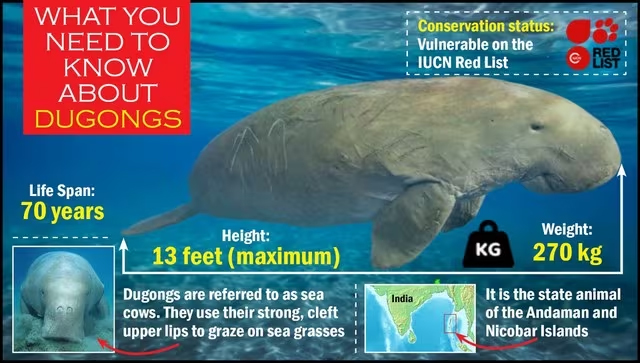Context:
A new report recently released by IUCN at the IUCN Conservation Congress revealed that the long-term survival of India’s dugong populations - especially in the Gulf of Kutch, Gulf of Mannar–Palk Bay, and the Andaman & Nicobar Islands - is now “highly uncertain.”
About Dugongs:
Dugongs are large, herbivorous marine mammals commonly known as "sea cows" that live in coastal waters and feed on seagrass. They are related to manatees, but unlike manatees, they are strictly marine animals with a dolphin-like tail.
Listed as Vulnerable on the IUCN Red List and protected under Schedule I of the Wildlife (Protection) Act, 1972.
Why Are India’s Dugongs Under Threat?
|
Threat |
Causes/Details |
Impact on Dugongs |
|
Seagrass Habitat Loss |
Dredging, coastal construction, port expansion, aquaculture, pollution, sedimentation |
Loss of primary food source → threatens survival |
|
Fishing Bycatch |
Dugongs entangled in gillnets; overlap with high-intensity fishing zones |
Major cause of deaths; hotspots: Tamil Nadu, Andaman & Nicobar, Gulf of Kutch |
|
Pollution & Toxic Metals |
Arsenic, cadmium, chromium, mercury, lead from industrial effluents, agricultural runoff, untreated sewage, marine litter |
Accumulation in seagrass → affects organs like liver & kidneys |
|
Slow Reproductive Rate |
Females reproduce once every few years; long gestation; high calf mortality |
Small additional losses can severely impact population viability |
|
Climate Change |
Rising sea levels, ocean warming, seagrass bleaching, increased storms |
Exacerbates habitat degradation and other anthropogenic threats |
Ecological Significance:
Dugongs are ecosystem engineers. Their grazing:
1. Maintains Seagrass Meadows
-
-
- Pruning promotes new growth
- Prevents overgrowth and decay
- Enhances carbon sequestration—critical for climate mitigation
- Pruning promotes new growth
-
2. Supports Marine Food Chains
By stirring sediments and releasing nutrients, dugongs help sustain populations of:
-
-
- Commercial fish
- Shellfish
- Sea cucumbers
- Other invertebrates
- Commercial fish
-
3. Economic Value: Research indicates that dugong-supported seagrass ecosystems contribute ₹2 crore per year in additional fish production.
Conservation Measures by the Government:
|
Year / Initiative |
Description / Actions |
Objective |
|
2010: Dugong Task Force |
Set up by MoEFCC to coordinate efforts |
Strengthen conservation planning and coordination |
|
National Dugong Recovery Programme |
Partnership with Tamil Nadu, Gujarat, Andaman & Nicobar Administration |
Habitat protection, research, community awareness |
|
2022: Dugong Conservation Reserve (Palk Bay, TN) |
Area: 448 sq. km; protects seagrass meadows |
Provides safe habitat; India’s first dedicated dugong reserve |
|
Legal Protections |
Schedule I species under the Wildlife Protection Act; penalties for hunting/trade; fishing restrictions in protected areas |
Prevent hunting, reduce bycatch, safeguard dugongs |
Conclusion:
Dugongs are an irreplaceable part of India’s marine heritage and coastal ecology. Their survival hinges on the health of seagrass ecosystems—one of the world’s most efficient natural carbon sinks. The increasing threat from human activities, pollution, and habitat degradation demands urgent and coordinated action.







